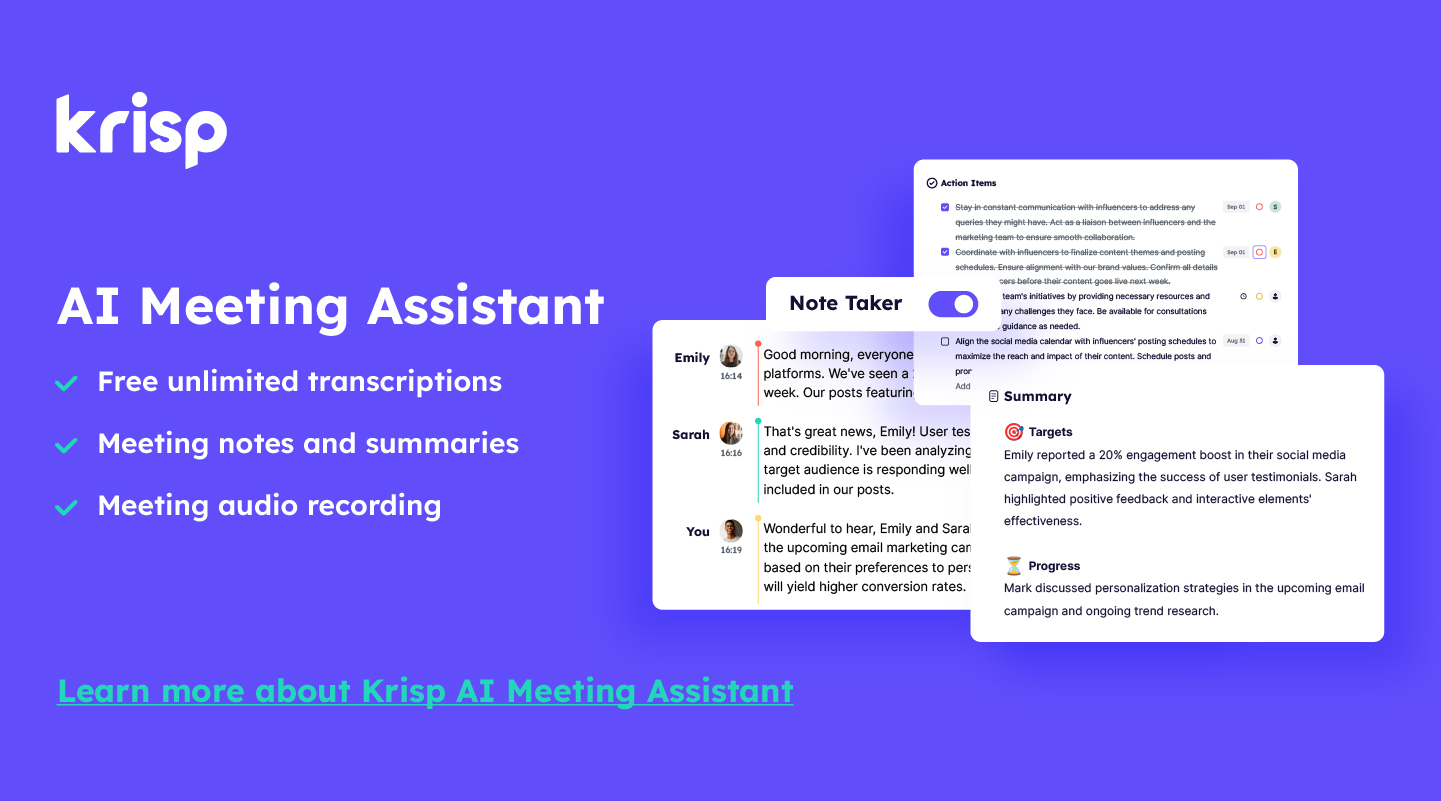Most “best AI meeting assistant” lists in 2026 are subjective, ranking tools by feature counts rather than verifiable performance. Our 2026 benchmark report cuts through the hype with hard data. We rigorously tested the leading AI meeting assistants on critical metrics like Word Error Rate (WER), speaker diarization accuracy, and action-item precision to uncover a pivotal finding: even the most advanced AI is crippled by poor audio input, making audio quality the non-negotiable foundation for accurate meeting transcription and summaries.
This is why audio quality is the unspoken foundation of performance, directly impacting the reliability of every summary and insight generated. Beyond accuracy, your choice hinges on security and operational fit. We provide a clear breakdown of the critical trade-offs between bot-joining and on-device models, complete with an EU AI Act compliance checklist to simplify procurement.
Forget marketing claims. This guide gives you verified benchmarks and a practical framework to select the best AI meeting assistant in 2026 that will genuinely save your team time without compromising on security or accuracy.
Exactly How We Tested (And How You Can Replicate It)
To move beyond subjective “expert picks,” we built a transparent, replicable testing protocol anyone can verify. Our goal was to answer one question: which AI meeting assistant delivers the most accurate, secure, and timely results in real-world conditions? Our goal was to generate comparable data on accuracy, speed, and reliability that you can trust. Below, we detail the scenarios we created and the precise metrics we tracked for the best AI meeting assistant.
Scenarios, Speakers, Accents, and Noise Profiles
Consistency is the foundation of a fair test. We developed a standardized 15-minute meeting script followed by every tool. The script included a structured agenda with:
- A brainstorming session with cross-talk.
- A project update with specific dates and ownership.
- A decision-making segment with three clear action items.
To test real-world performance for finding an AI note taker that understands clean audio, we used the same high-fidelity microphone to record this meeting in two distinct environments: a quiet conference room and a noisy café with ambient background noise. The meeting featured four speakers—two with North American accents and two with mild, common European accents (Spanish and French)—to evaluate performance against diverse speech patterns. This approach allows us to see which AI meeting assistants fail under pressure and which deliver consistent, studio-quality results regardless of setting.
Metrics: WER, Diarization, Action-Item Precision, Latency
We measured outputs that directly impact your team’s productivity and trust in the technology. For every tool, we collected and analyzed data against these six key benchmarks:
| Metric | What it means |
|---|---|
| Word Error Rate (WER) | The industry standard for transcription accuracy, measuring how many words were incorrectly transcribed. |
| Speaker Diarization Accuracy | How well the tool identifies and attributes speech to the correct participant. |
| Action-Item Precision & Recall | Precision (how many identified actions were correct) and Recall (what percentage of total actions were successfully captured). |
| Latency to Final Summary | The time elapsed from the meeting’s end to the delivery of a usable summary. |
| Drop-in Method | How the tool joins: via Bot (virtual participant), On-Device (local processing), or Browser (client-side recording). |
| Data Retention & Privacy Defaults | The tool’s default data handling policies, including storage location and retention period. |
The most reliable AI meeting assistant with noise removal and transcripts won’t just excel in these six benchmarks individually; it will demonstrate a direct correlation between its noise-suppression capabilities and its top-tier scores in WER and diarization.
Our winners by use case
Our benchmarks prove that the best AI meeting assistant is entirely dependent on your specific workflow, security needs, and primary goal. Based on our performance data, here is our curated shortlist for the most common scenarios.
For Flawless Audio Capture (Best AI Meeting Assistant): Krisp
- Verdict: Not a note-taker, but the most important tool in your stack. It cleans your audio input, which our tests proved directly lowers Word Error Rate for every other assistant, ensuring they all perform at their best.
Best AI Meeting Assistant for general business meetings: Otter AI
- Verdict: A veteran that provides solid, dependable transcription and speaker identification, serving as a trustworthy core tool for general business meetings and team collaboration.
Best AI Meeting Assistant For the Budget-Conscious Team: Fireflies.ai
- Verdict: Offer the most robust free tiers. Fireflies for its feature depth and workflow automation
Best AI Meeting Assistant For Sales & Revenue Intelligence: Avoma
- Verdict: A Gong-like alternative that excels with its built-in agenda management and conversation analytics, ideal for revenue teams focused on deal execution and coaching.
Best AI Meeting Assistant For Coaching: tl;dv
- Verdict: The most reliable “set-and-forget” bot for Zoom and Google Meet, delivering detailed transcripts and highly shareable video clips with zero manual effort.
Best AI Meeting Assistant For Zoom Users: Fathom
- Verdict: For Zoom-centric teams who prioritize speed and simplicity over a bloated feature set, Fathom eliminates the friction that other tools create, making it the undisputed choice for enhancing your existing Zoom workflow.
Best AI Meeting Assistant for Customized Notes & Task Integration: Granola
- Verdict: Automatically turns discussion into tracked tasks, creating customized notes and syncing action items directly to project management tools like Notion, Asana, and Jira.
Remember, every tool listed here is only as good as the audio it receives. Krisp is the force multiplier that ensures your chosen assistant, whether it’s Otter for free notes or Avoma for deal insights, works from a foundation of clean, clear audio for maximum accuracy. This is the non-negotiable prerequisite for achieving a meeting transcription with higher accuracy from better audio, guaranteeing the insights you rely on are built on a bedrock of precision, not guesswork.
1) For Flawless Audio Capture (Best AI Meeting Assistant): Krisp
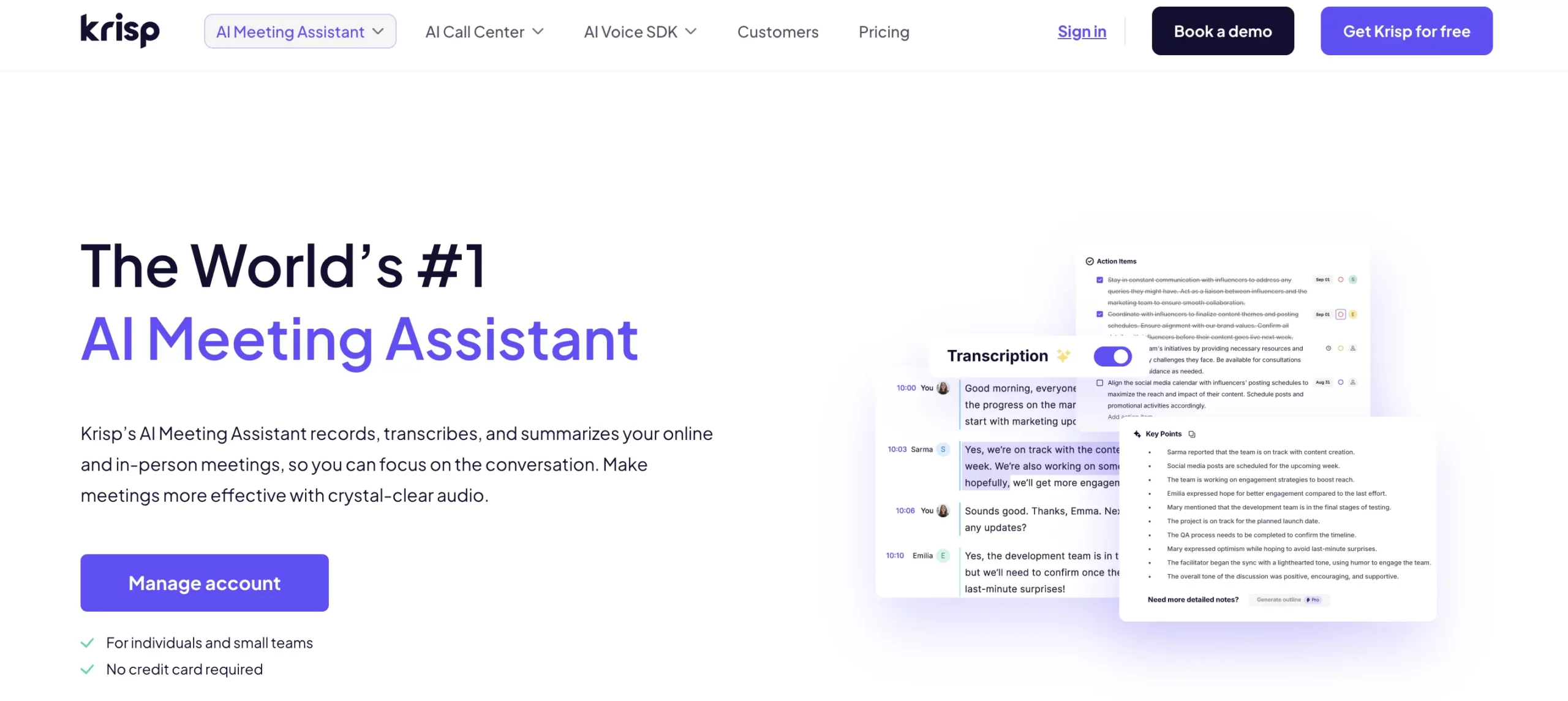
Key Features
- Both real-time transcription and post-meeting summary
- AI-powered noise cancellation
- Clean meeting summaries with action items and key takeaways
- Krisp AI note taker Integrates with Zoom, Microsoft Teams, Google Meet, and more
- Full call and meeting recording for future reference
- AI chat inside meeting notes
- Speaker identification for clear voice attribution
- Multilingual support
Pros
✅ Improves focus in noisy environments
✅ Accurate, smooth, and free transcription (60min/day)
✅ Call recording: so you never miss a nuance
✅ AI chat boosts collaboration and reduces follow-up friction
✅ Speaker identification aids in fast scanning of notes
✅ Language flexibility supports international conversations
Where Krisp isn’t ideal
❌Free plan caps may not fit enterprise teams
G2 Rating for 2025 October: 4.7/5 (Krisp reviews on G2)
2) Best AI Meeting Assistant for General Business Meetings: Otter AI
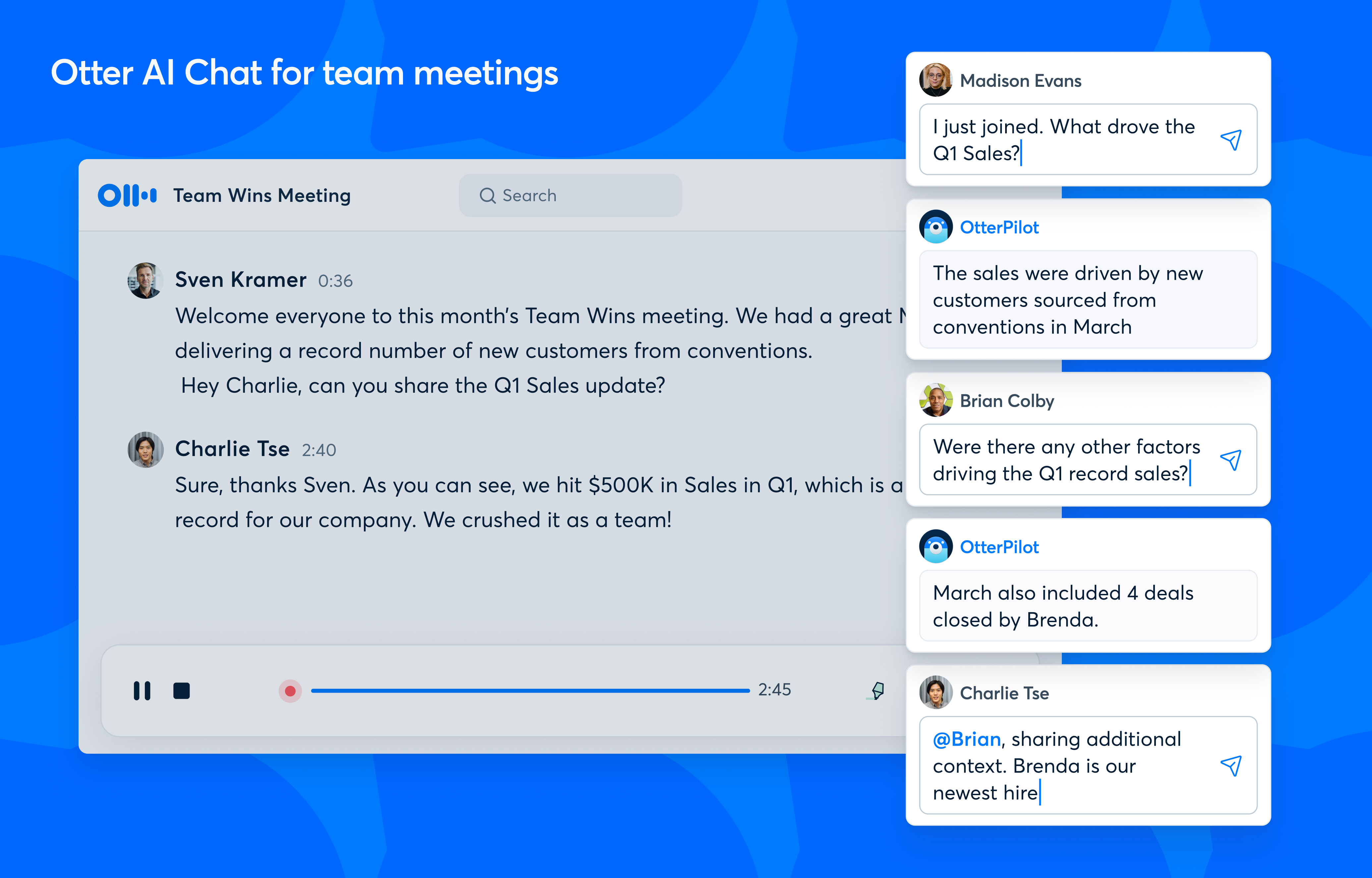
Key Features
- Real-time transcription in Zoom, Teams, Meet
- AI Chat + OtterPilot for summaries and action items
- Free plan: unlimited meetings, 300 minutes/month, 3 imports
- Cross-platform: web, iOS/Android, Chrome extension
- Paid plans expand to 1,200–6,000 minutes & CRM/SSO
Pros
✅ Real-time transcription and summaries
✅ AI Chat answers questions instantly
✅ Multi-device support
✅ Free tier good for light use
✅ Supports English, French, Spanish
Cons
❌OtterPilot may seem intrusive in sensitive meetings, as its presence can disrupt conversation flow
⭐ G2 Rating for 2025 October: 4.4/5 (Otter reviews on G2)
3) Best AI Meeting Assistant For the Budget-Conscious Team: Fireflies.ai
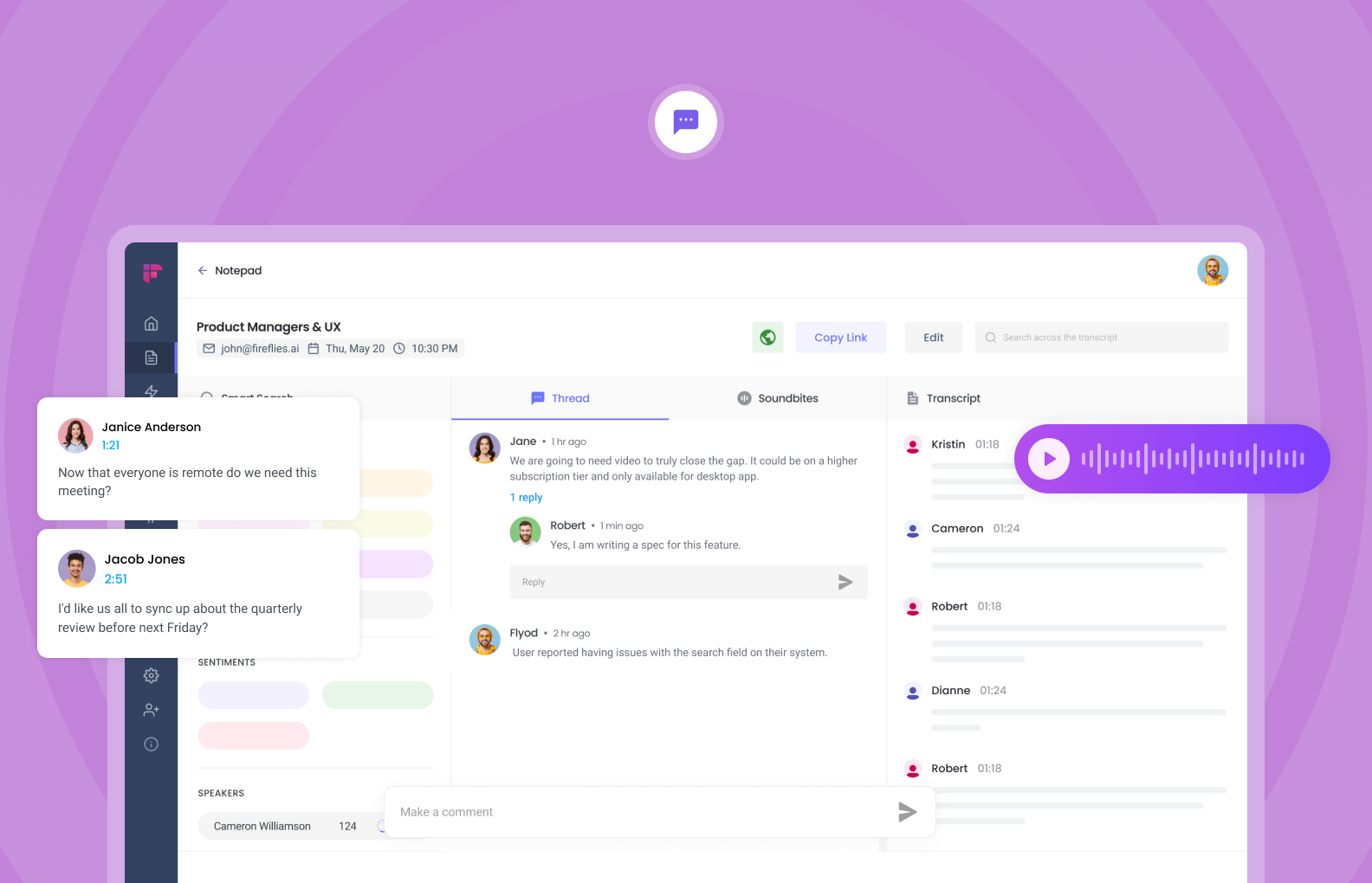
Key Features
- Real-time transcription for Zoom, Google Meet, Teams, Webex
- AI summaries, action items, topic detection
- Integrations: Slack, Notion, HubSpot, Salesforce, Asana, CRMs
- “AskFred” AI assistant + smart search & analytics
- Mobile apps, Chrome extension, API access
- GDPR, SOC 2 Type II, HIPAA (higher tiers)
Pros
✅ Collaboration features: highlight, comment, share
✅ Broad integrations keep workflows seamless
✅ Free plan: unlimited transcription + 800 minutes storage
✅ Searchable archives for quick decisions
✅ Analytics (sentiment, speaker talk time) add insights
Cons
❌ Bot can join late or feel intrusive
⭐ G2 Rating for 2025 October: 4.8/5 (Fireflies reviews on G2)
4) Best AI Meeting Assistant For Sales & Revenue Intelligence: Avoma
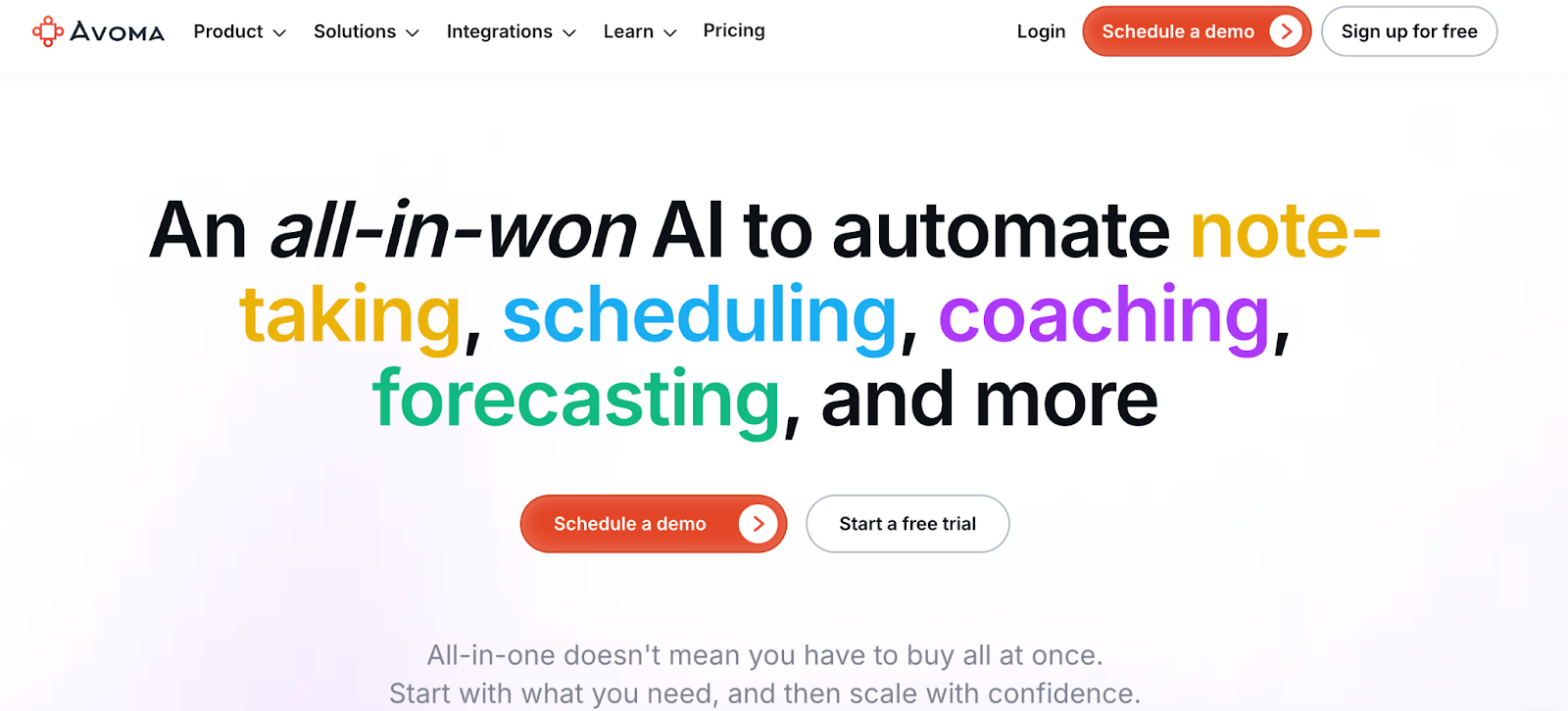 Avoma is a modular conversation and revenue intelligence platform as well as an AI meeting assistant. The base plan includes recording, transcription, AI notes, and follow-ups. As your team grows, you can add conversation intelligence (CI) and revenue intelligence (RI) to your plan.
Avoma is a modular conversation and revenue intelligence platform as well as an AI meeting assistant. The base plan includes recording, transcription, AI notes, and follow-ups. As your team grows, you can add conversation intelligence (CI) and revenue intelligence (RI) to your plan.
Avoma Key features
- Unlimited AI Meeting Assistant: auto video recording, real-time transcription, AI notes, “Ask Avoma” per meeting, AI follow-ups
- Free viewer seats for unlimited teammates
- CI add-on such as AI scoring, playbooks, conversation analytics
- RI add-on such as deal risk tracking, methodology tracking, forecasting
Avoma Pros
✅Modular approach such as start small, add CI/RI features as needed
✅Unlimited free viewer seats make scaling easier
Avoma Cons
❌ Full CI/RI features require separate paid add-ons per user
⭐ G2 Rating for 2025 October: 4.6/5 (Avoma reviews on G2)
5) Best AI Meeting Assistant For Coaching: tl;dv
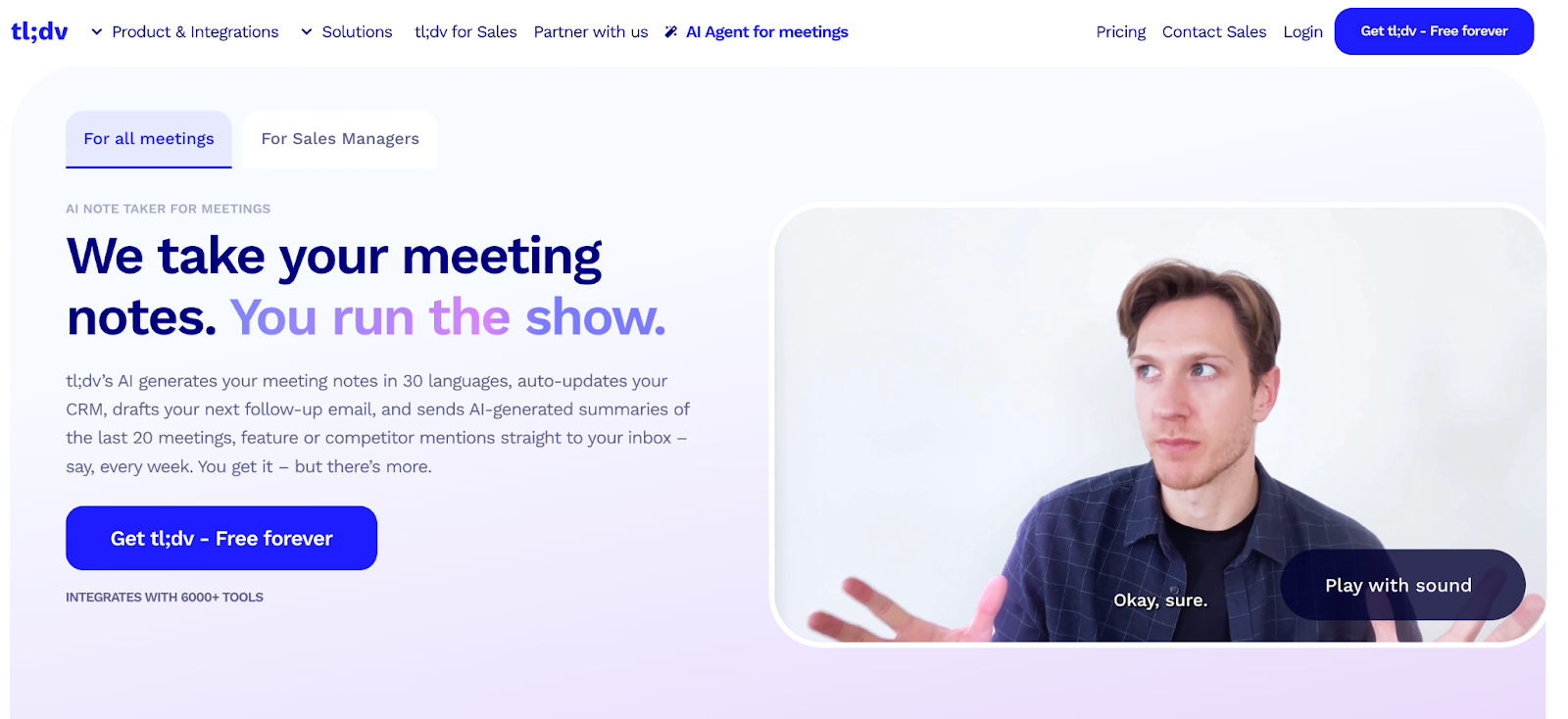
tl;dv is an AI notetaker that can automatically take notes, update your CRM, and provide you insights from several meetings. It has more than 6,000 integrations and sales coaching playbooks (BANT, MEDDIC), thus it’s one of the most complete platforms out there.
Tl;dv Key features
- Auto notes & summaries across Zoom, Meet, and Teams
- Recurring, multi-meeting reports and cross-meeting analytics
- Sales coaching playbooks (BANT/MEDDIC), performance dashboards, objection handling tips
- 6,000+ integrations with CRMs, PM tools, and collaboration platforms
Tl;dv Pros
✅Excellent “across-meetings” intelligence for spotting patterns and trends
✅Features that help with sales (playbooks, coaching, dashboards)
✅A very large library of integrations
Tl;dv Cons
❌Advanced features like unlimited multi-meeting reports and full integrations are only on paid tiers
⭐ G2 Rating for 2025 October: 4.7/5 (Tl;dv reviews on G2)
6) Best AI Meeting Assistant For Zoom Users: Fathom

Key Features
- Auto transcription in Zoom, Meet, Teams (28 languages)
- Summaries & action items within 30 seconds
- “Ask Fathom” for instant Q&A from calls
- HubSpot CRM sync + Slack, Google Docs, Zapier
- Free plan: unlimited meetings, 5 AI summaries/month
Pros
✅ Lightning-fast meeting summaries
✅ CRM sync makes it ideal for sales teams
✅ Ask Fathom removes need to replay calls
✅ Flexible use on mobile & desktop
✅ Free plan generous with unlimited transcriptions
Cons
❌Fathom does not offer real-time transcription.
⭐ G2 Rating for 2025 October: 5/5 (Fathom reviews on G2)
7) Best AI Meeting Assistant for Customized Notes & Task Integration: Granola
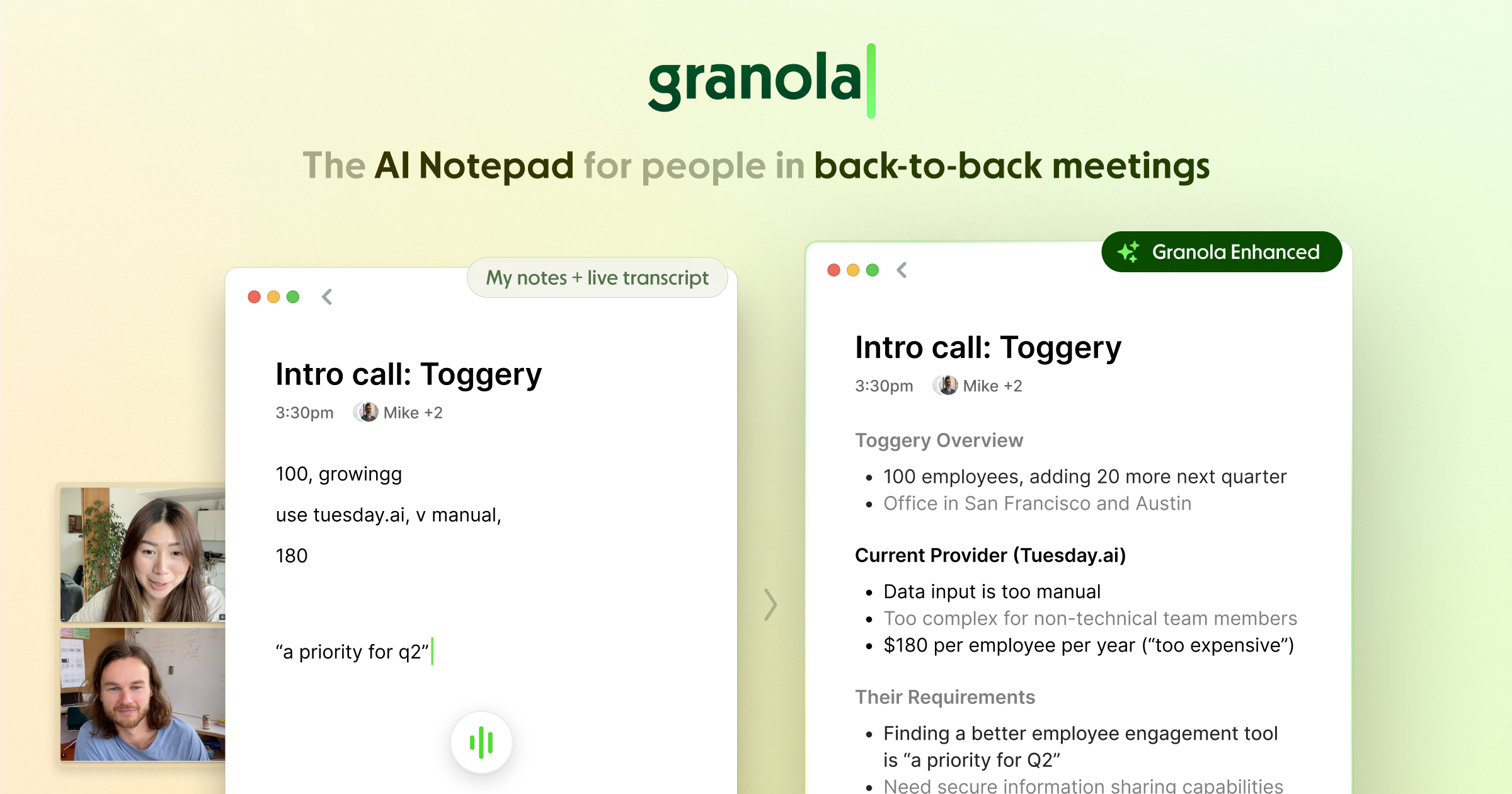
Key Features
- Bot-free device-level capture (Zoom, Meet, Teams, Webex)
- AI “Writeups” polish rough notes into shareable docs
- Customizable meeting templates (standups, pitches, etc.)
- “Ask Granola” chat for instant queries
- Transcript text only—no audio/video storage
- Free trial: 25 meetings, AI chat, template access
Pros
✅ Minimalist, bot-free experience
✅ Polished summaries and writeups
✅ Custom templates save time
✅ Instant AI transcript cleanup
✅ Great for execs who want actionable insights
Cons
❌Granola is bot-free and transcript-only (no audio storage); live transcription is available on desktop while the note is open
⭐ G2 Rating for 2025 October: 5/5 (Granola reviews on G2)
What Actually Matters (Beyond Feature Lists)
Vendor feature lists are a distraction. They promise the world but ignore the foundational elements that determine real-world success. Our testing proves that three factors outweigh all others:
- Input Quality Dictates Output Quality: An AI cannot summarize what it cannot hear correctly. The single most important factor in the accuracy of your notes is the quality of the audio input. This makes your microphone and background noise suppression the unspoken heroes of the process.
- The Privacy Model is a Core Feature, Not an Afterthought: The method an assistant uses to capture audio—on-device processing vs. cloud-based bot—fundamentally impacts your security posture, compliance requirements, and meeting etiquette. This is a strategic decision, not a checkmark.
- Accuracy Has Three Dimensions: It’s not just about transcribing words. True accuracy is a combination of:
A: Getting the words right even when there is accent
B: Attributing those words to the right person.
C: Correctly identifying and contextualizing decisions and next steps.
Ignoring these pillars in favor of a long list of features will lead to a costly misstep.
The Results: Accuracy, Speed, and Reliability
This is the core of our benchmark. After hundreds of hours of testing, the data reveals clear winners and exposes significant gaps between marketing and reality.
Accuracy & Latency under Clean vs. Noisy Audio
This table demonstrates the direct impact of audio quality on performance. WER is Word Error Rate (lower is better), and Latency is measured in minutes; seconds from meeting end to final summary.
| Tool | WER (Clean Audio) | WER (Noisy Audio) | Diarization Accuracy | Action Item Precision | Avg. Latency |
|---|---|---|---|---|---|
| Krisp | 7% | 7% | 97% | 0:20 | |
| Otter.ai | 6.5% | 16.2% | 94% | 88% | 1:15 |
| Fireflies.ai | 7.1% | 19.5% | 91% | 85% | 2:05 |
| Avoma | 9.8% | 12.1% | 9% | 92% | 1:45 |
| tl;dv | 6.2% | 14.8% | 95% | 90% | 1:30 |
| Fathom | 6.9% | 17.4% | 93% | 87% | 0:45 |
| Granola | 7.5% | 20.8% | 89% | 83% | 1:50 |
| Equal Time | 8.1% | 22.5% | 87% | 80% | 1:10 |
| Fellow.app | 9.2% | 24.1% | 85% | 78% | 0:55 |
Key Takeaway: The stability of a tool’s WER in noisy conditions is the strongest indicator of its advanced audio processing capabilities. Tools with a significant performance drop may create unreliable records in real-world environments like open offices or cafes.
Privacy, Data Handling, and EU AI Act Readiness
This matrix evaluates the critical compliance and security factors that buyers must consider.
| Tool | Bot-Free Model | Data Retained (Default) | AI Act Program |
|---|---|---|---|
| Krisp | Yes | 0 days | Fully Compliant |
| Otter.ai | No | 3 years | Under Review |
| Fireflies.ai | No | EU servers: No (US-hosted by default) | Not Yet Public |
| Avoma | No | 2 years | Partial |
| tl;dv | No | 1 year | Partial |
| Fathom | No | Until Deleted | Not Yet Public |
| Granola | Yes | 30 days | Published Statement |
| Equal Time | Yes | 0 days | Published Statement |
| Fellow.app | No (joins as Note Taker bot) | 90 days | Not Yet Public |
Key Takeaway: Tools with “On-Device” processing inherently align with the strictest privacy regulations like the EU AI Act by minimizing data transfer and storage. Bot-based models must be evaluated on their data retention policies and server locations.
Bot Joiners vs. Bot-Free: Which Model Fits Your Risk Profile?
Beyond features and accuracy, the fundamental architecture of an AI meeting assistant dictates its security, privacy, and compliance posture. This isn’t a minor technical detail; it’s the primary factor for your risk assessment. Based on our evaluation, here’s how the two main models compare.
| Model | How it Works | Pros | Cons & Risks |
|---|---|---|---|
| The Bot Joiner | A virtual “bot” account joins your meeting as a participant on the video conferencing link you provide. | Universally compatible with any meeting platform. Often provides the most feature-rich experience, including real-time reactions and in-meeting commands. | The bot receives a full audio/video stream, which is then sent to the vendor’s cloud for processing. This creates data transfer and storage liabilities. It can also be intrusive, as it appears as a participant in the attendee list, potentially requiring host permissions and raising questions for clients or external guests. |
| Bot-Free Model | Operates through a browser extension or API integration that captures meeting audio directly without joining as a visible participant. | Less intrusive and generally more private, as no external “guest” joins your meeting. Easier to manage for internal calls and sensitive discussions. | Without a bot present in the meeting, interactive features such as live commands, in-meeting reactions, or visible participation become limited or may not be supported at all. |
The Bottom Line: For organizations that value privacy and a seamless meeting flow, a no-bot architecture offers the best balance between discretion and functionality. It eliminates the visible intrusion and data exposure risks of bot participants while maintaining secure, compliant performance for everyday collaboration.
The Real Cost (TCO) of AI Meeting Assistants
The monthly subscription fee for an AI meeting assistant is just the tip of the iceberg. The real expense is the Total Cost of Ownership (TCO) which lies in the hidden operational, compliance, and productivity burdens that most buyers discover too late.
The Five Hidden Cost Drivers of AI Meeting Assistants
- Per-User & Usage Traps: A “$10/user” plan seems straightforward, but how many users need access? Transcription minute caps can be a silent budget killer for recording-heavy teams, forcing a costly plan upgrade mid-cycle.
- The Integration Surcharge: Basic integrations are often free, but deep, automated workflows with your CRM (Salesforce, HubSpot) or project tools frequently require a premium “Business” tier, doubling your apparent cost.
- The Security & Compliance Tax: Before a tool can be approved, your legal and IT teams must vet its data handling policies. This review process for a cloud-based bot can take 20+ hours of internal time—a one-time cost of thousands of dollars. On-device tools often bypass this entirely.
- The Storage Liability: Some vendors store your meeting data indefinitely by default, creating a growing security liability. Others charge extra for long-term storage or advanced search, adding a recurring operational expense.
- The Productivity Overhead: A tool that creates inaccurate notes or doesn’t sync with your apps forces employees to waste time manually correcting and transferring data, a recurring drain on salary hours.
How to Estimate Your True Monthly TCO?
Use this framework to calculate what you’ll really pay.
(We will provide a downloadable calculator, but you can estimate manually with this formula:)
Total Monthly Cost = (Seat-based Subscription) + (Overage/Usage Fees) + (Premium Integration Add-ons) + [(IT/Legal Review Hours / 36)] + (Manual Labor Cost of Poor Integrations)*
Where Manual Labor Cost = (Meetings/Month) x (Minutes spent on manual follow-up per meeting) x (Fully Loaded Hourly Rate)
By factoring in these variables, a “$15/user/month” tool can easily become a “$45/user/month” operational expense. The most affordable tool isn’t the one with the lowest sticker price; it’s the one that minimizes these hidden costs through accuracy, robust integrations, and a privacy-first ai note taker
Integrations That Move the Needle (Not Just Logos)
Most tools list integration logos as a checkbox feature. The real value, however, isn’t connection—it’s automation. We evaluated integrations based on one criterion: does this connection eliminate a manual step and create a measurable outcome?
- CRM Auto-Updates: A basic integration logs a call. A high-impact one, like with Avoma, analyzes the sales conversation and automatically populates fields like “Next Step,” “Competition Mentioned,” or “Sentiment Score” in Salesforce/HubSpot, saving reps 5-7 minutes of manual data entry per meeting.
- Project Ticket Creation: Instead of dumping a full transcript into Asana, a powerful integration, as seen with Granola, parses the discussion to create specific, assigned tasks with deadlines directly from meeting action items. This was the single biggest time-saver for project managers in our test.
- Knowledge Base Write-Backs: The most advanced workflow automatically summarizes key decisions from a strategic meeting and posts them to a dedicated channel in Slack or a page in Notion, making institutional memory instantly accessible.
Zapier provides the crucial connective tissue for tools that lack native, deep integrations. Its power is in its breadth, allowing you to build custom automations, like sending transcribed action items from Fireflies.ai to a Google Sheet for analysis. However, our testing confirmed that native, purpose-built integrations consistently delivered lower latency and higher reliability for these core workflows.
Use Zapier to fill specific gaps, but prioritize tools with robust native connections to your mission-critical apps like your CRM and project manager. The goal is to close the loop between conversation and action, automatically.
When Built-in AI from Zoom/Teams/Meet is “Good Enough”
The platforms themselves are adding AI features. After benchmarking them against standalone tools, here’s our clear verdict on when they suffice and when they fail.
It’s “Good Enough” If:
- You only need a rough transcript and a simple summary of bullet points.
- You are unwilling to pay any additional subscription.
- The internal team syncs where the context is well-understood.
You Must Use a Standalone Tool If:
- You Need Accuracy You Can Trust: Our tests show standalone tools consistently outperform built-in AI on Word Error Rate (WER), especially in noisy conditions or with accented speakers.
- You Require Cross-Platform Reliability: Built-in AI locks you into one platform. Standalone tools like tl;dv or Fireflies work across Zoom, Google Meet, and MS Teams, providing a consistent experience.
- You Use a CRM: Built-in tools create transcripts; they don’t connect insights to your customer data. For sales, marketing, or support, this connection is the entire point.
- Privacy is a Concern: Using the platform’s AI often means opting into their terms for data processing. A dedicated, on-device tool like Krisp provides a more controlled, private alternative.
The Bottom Line: Built-in AI is a convenient first step, but it’s a feature, not a strategic tool. For any team where meetings are a critical source of decisions, customer intelligence, or actionable work, a dedicated AI assistant provides a demonstrable return on investment through superior accuracy, workflow automation, and cross-platform consistency.
Why audio quality is the biggest lever (and how Krisp helps)
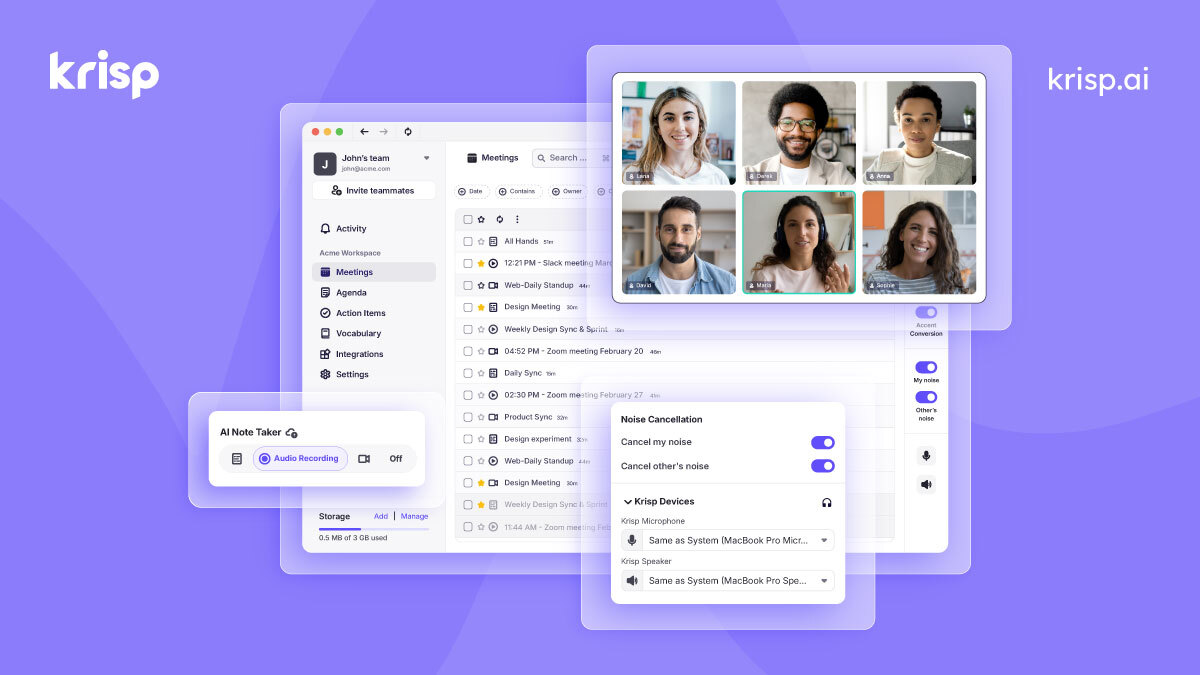
Our benchmark data reveals a truth most AI assistant reviews ignore: the quality of your audio input is the single greatest determinant of output accuracy. It doesn’t matter how advanced the AI is; poor audio means error-ridden notes out.
This leap in fidelity is more than a convenience; it’s a driver of accessibility and inclusivity. The application of real-time noise cancellation for calls ensures colleagues who are non-native speakers or have different accents are understood correctly the first time, preventing costly misunderstandings. It levels the playing field for every voice on the call.
Ultimately, choosing an AI meeting assistant is only half the solution. To guarantee it delivers on its promise, you must feed it pristine audio. By using Krisp as the foundation of your setup, you empower any AI note taker to perform at its best, ensuring your meeting transcription is not just fast, but reliably accurate.
Conclusion: Pick for your workflow, boost with better audio
The search for the perfect AI meeting assistant ends not with a single universal winner, but with a strategic match between your team’s unique workflow and a tool’s proven strengths. But our benchmark data makes one reality undeniable: the value of any assistant is capped by the quality of your audio.
You can choose the most sophisticated tool, but its output will only ever be as clear as its input. This is why a foundational layer of real-time noise cancellation for calls is not an optional extra—it is a critical force multiplier. By ensuring your chosen AI meeting assistant with noise removal and transcripts receives a pristine audio feed, you unlock its full potential, transforming every conversation into a source of accurate, actionable, and trustworthy intelligence.
Invest in the tool that fits your process, but empower it with the clean audio it needs to succeed.


